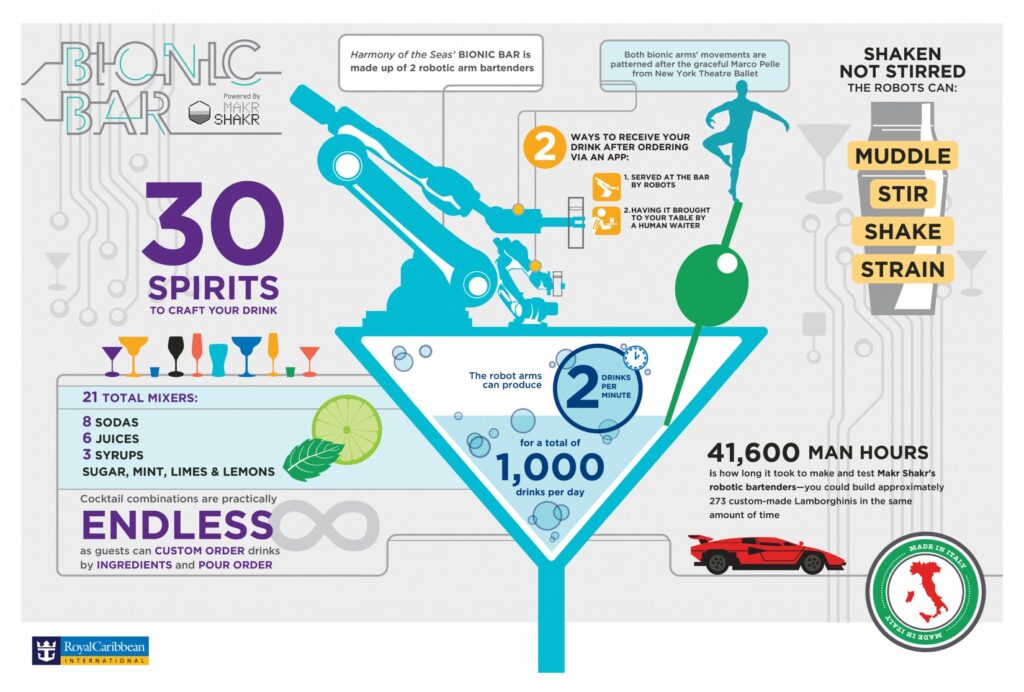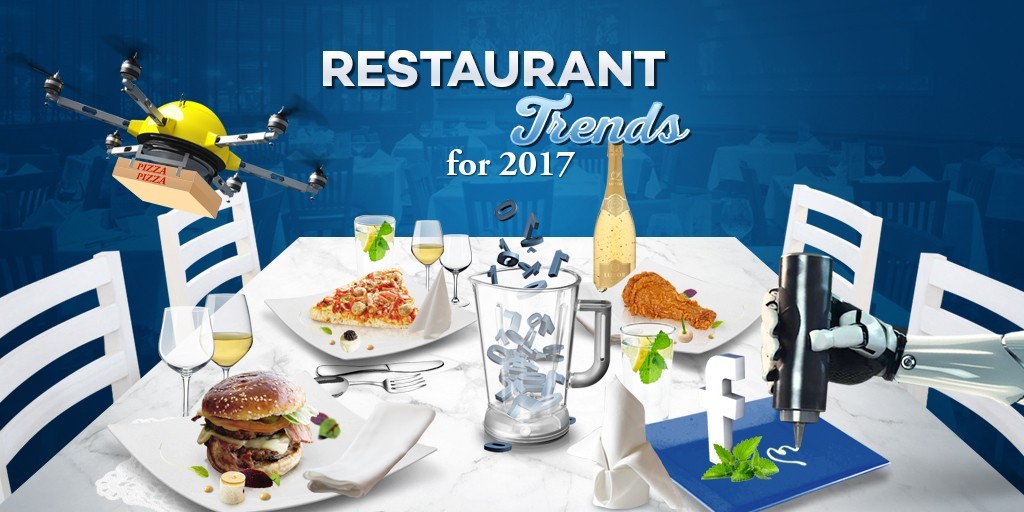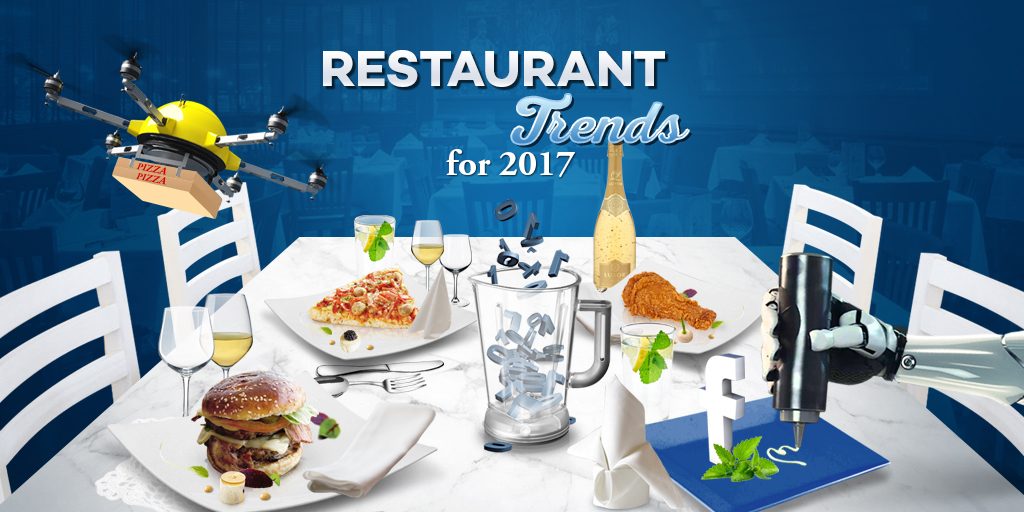2016 has seen huge changes in the Restaurant industry with consolidations, closures, openings, some big wins and huge losses. We look at what we are seeing as shaping up as the big restaurant trends for 2017 and further in the Restaurant industry so that you can better position your Restaurant to benefit from these big trends.
Update: You can now listen to Restaurant Trends for 2017 on the Secret Sauce Podcast.
The meta trends we see impacting the Restaurant industry come from increasing competition and technology.
Restaurant Technology a big factor in Restaurant Trends
All kinds of Small Businesses are being impacted by growing technological changes within their industries and restaurants are no different. The overall trend that we are seeing is that the pace of change with technology is increasing dramatically which means that it is more important than ever to really understand what the big trends are going to be, so that your Restaurant can plan appropriately.
There is always competition in Restaurants, but the competition is fiercer than ever
Fierce competition is being bought on buy not only the number of Restaurants out there, but the increasing segmentation of the marketing. This means that a generalist family restaurant is having it’s fairly large possible market being targetted by restaurants picking off small niches of the target market – vegans, family specific, gluten free, grown local, community, one item speciality, and delivery to name a few of the niches that Restaurants are diving into to increase their revenue and profit.
1. Restaurant Home Delivery.
2016 has seen a huge amount of change with Delivery. UberEats has increased market share dramatically in urban centres that they are serving and the introduction of UberEats has introduced the concept of Delivery to many restaurants who last year would never of thought of doing home delivery.
We are seeing a big difference between the early entrants in the market for online ordering, the Menulogs, Just Eats, Grub Hubs and Delivery Heros and the more recent entrants, which wrap up online ordering with delivery logistics – companies like Uber Eats, Deliveroo and Foodora.
Given the rise of the second generation of online ordering companies, we have seen a lot of change in the market.
We have seen Delivery Hero exit Australia.
Just Eat bought Hungry House and SkipTheDishes.
Delivery Hero bought Foodpanda.
Menulog got a new CEO (from Groupon)
The consolidation will decrease competition and therefore we think that we will see further increases in the commissions charged by companies like Just Eat and Menulog, especially where there is 1 dominant online ordering company. This will be particularly so in areas that aren’t served by UberEats or Deliveroo. The logistics companies require a density of drivers, restaurants and customers and the further from large cities they go, it becomes harder to generate the work and orders to make it cost effective.
Even if you aren’t contemplating delivery, the fact that more Restaurants are now offering delivery is something that you need to be aware of, because for some of those customers, they could have been a dine in customer, but instead, they have decided to eat in, making it just that little bit harder for you to hit your revenue numbers.
We ate lunch yesterday in a Restaurant and talking to the manager, he said that the previous day they had done 85 orders – these were all with UberEats. Like many restaurants, they were listed on UberEats, Foodoro and Deliveroo, but the vast majority of their orders came from UberEats. Their Foodoro system was broken, so Foodoro where phoning through orders, but because the volume was only 1 or 2 orders a week, it didn’t matter too much. The Restaurant was an American BBQ Joint and they would have never considered delivery before, but with UberEats covering the logistics of delivery, they are able to target a much larger audience and take out is often more than dine in revenue.
Self driving cars for Restaurant Deliveries
Dominos is trialling self driving vehicles for pizza delivery and we think that this will become a viable option for delivery a lot quicker than a lot of people think. We think that this year there will be serious trials around SDV for food delivery and we expect that by the end of 2017 there will start to be options available in some areas of the United States for self driving delivery vehicles.
Drones for Restaurant Deliveries
There has been a lot of progress made with Drones for Restaurant delivery in 2016. Flirtey has done commercial deliveries for 7-Eleven in the US and Dominos in New Zealand and we expect there to be a lot more offerings around Restaurant Drone Deliveries.
2. Marketing.
Sadly, we saw some great local Restaurants close this year and is becoming even more apparent that Great Food, Great Value and Great Experiences sometimes (often) aren’t good enough because we are seeing more and more average (or poor) Restaurants that are outmarketing the better restaurants, getting all of the customers and making the profit. . For those that we had eaten at, sometimes the food and service was poor and there was no real surprise that they had closed, but for others, sometimes the food was good, sometimes really, really good.
The trend towards Restaurants experimenting not only with Facebook and Instagram, but experimenting with the Menu in order to create great Social Media campaigns will continue.
Less than 8% of small Restaurants are posting every week to Facebook themselves and only 2% are running Facebook ads. We see this as being one of the biggest trends that will occur in 2017 as more Restaurants discover the significant increase they can get in Revenue from running simple Facebook ads.
There will also be an increase in the number of Restaurants using Restaurant CRM systems. Being able to understand who your customers are and provide them with the experiecne that they are after is a clear differentiator in the marketplace and with Free Restaurant CRM systems becoming available, it enables Restaurants to build rich databases of their customers orders and bookings, preferences and key dates, often with very little work within the Restaurant.
3. Bigger Data for Small Restaurants.
We are seeing more and more small Restaurant businesses leveraging their data to increasing productivity, sales and profits. Most small Restaurants don’t have access to the kinds of data that would qualify as Big Data in a traditional sense, but Restaurants are starting to realise the importance of collecting their own data, analysing it and acting on it.
Options that we have seen Restaurants using including using Facebook to crowdsource menu ideas and roadtesting virtual products before they even start in the kitchen to see how much interest there is, using Restaurant Comparative Analytics to determine if their website and marketing campaigns are effective and how they compare to their peers.
Restaurants will also become more adept at using Facebooks Big Data capabilities, not only for marketing purposes, but in menu engineer and menu design, customer research and demographic profiling.
4. Automation – The Rise of the Restaurant Robots.
The Sushi Train chain of Restaurants have for years had the little trains that act as little front of house workers, chugging tasty servings of nigiri and Californian Rolls to hungry customers for many years. Front and back of house automation has in the past been seen as a gimick, but with the two forces of rising wage costs and the decreasing costs of in-house automation, there will be more restaurants looking to extract decreased costs and in increased profits with automation.
There will be two strategies when it comes to Restaurant robots and automation. There will be those that use the automation to increase productivity and either cut cost or use the savings to create a better customer experience, and there will be those that will embed the automation as a part of the experience, just as Sushi Train has.
Coffee machines are a prime example of an area that many Restaurants could use automation in. Well trained Baristas are difficult to find and coffee automation has becoming much better in recent years. Companies like Poursteady have been making increasingly efficient coffee machines, saving on labour costs and increasing the number of coffees that can be served per hour.
The much anticipated Momentum Machines Restaurant didn’t appear in 2016, but their Burger making technology, or something like it will become more common in the kitchens as we move forward. Royal Caribbean International Cruise Line has implemented robot bartenders on a number of their ships, combining the aesthetic and experience of a robot bartender with the efficiency created with a bartender that doesn’t need training, sick leave or rest breaks.

This Robot Bartender installed on a number of Royal Caribbean ships is showing the way for automation
Many restaurants have outsourced their automation, buying in pre prepped food, but as more restaurants want to either prepare fresh or use local ingredients, they will look towards automation to provide the cost savings to make these ideas economically sustainable.
5. Consolidation.
The big Restaurant news in Australia was Urban Purveyor Groups acquisition of Rockpool Group to form the Rockpool Dining Group. The group now has 47 venues, 15 brands, revenue of $350 million and over 3,000 employees. Their long term plans include growing to over 200 venues over the next couple of years. The consolidation was backed by Quadrant Private Equity.
For Rockpool Dining Group and many of the companies like them, aggregating a large number of Restaurants into one group makes a lot of sense. They get the benefits of the Corporate Services of a large group, like HR, Marketing, Legal, Property Services (leasing and maintenance) whilst maintaining the benefits of single location Restaurants (location and community based marketing, diversified brands and the ability to experiment with brands and menu items). This can make them very difficult to compete against, so there is a lot of interest in scaling up from 1 to multiple restaurants, however it is incredibly difficult.
Growing from 1 restaurant to 2 starts to give economies of scale, but the second restaurant is the hardest. One of our customers once said that he had 3 restaurants, 1 great, the other 2 really struggled. The funny thing was that it was always the one that he was in that was doing really well. This highlights the need for systems, people and culture when trying to scale up the number of restaurant sites in your business. Technology can greatly assist Restaurant owners as they start to scale out their dream. The next generation of restaurant owners are using tools more often used by application developers to communicate and plan their work. Tools like Confluence, Slack, Zoom and IP Cameras provide restaurant owners the ability to more easily manage multiple sites, build and enforce a strong culture and design and evolve systems for each Restaurant.
The difficulties in scaling up means that the larger groups will continue to get larger in an effort to create larger economies of scale, increasing profits and enabling them to be more price competitive. Smart operators of single sites will utilise the new technologies tools that make it easier for a small business to scale up.
6. Specialization.
Restaurants that cater for everyone are appealing to no one because they aren’t really great at anything. We are seeing more Restaurants really focusing on being something special to a niche market, whether it be vegan, allergy free, family friendly, menu item specific, (Burger joints are seeing a resurgence in some areas), or delivery only. It is becoming increasingly difficult to be a generic cuisine based restaurant, without also focusing on a number of niches that can drive revenue.
Community Restaurants will become increasingly popular
Restaurants will continue to look for traction by focusing on their local market. Some Restaurants we talk to have a target number of regular local customers per week. This enables them to have highly predictable income and build strong relationships with a number of local customers. They are doing this through a number of channels.
- Local networking groups
- Using local produce and leveraging the networks of the local producers
- Co-marketing activities with other local businesses
- Facebook local advertising
- Menu items that highlight the local focus of the Restaurant
- Working with local sporting clubs (vouchers for players can be very profitable)
- Drinks menus allowing them to give a similar experience to a local bar
Community Restaurants will become more important as people start to look for a way to re engage in their physical community. Too many people are struggling with too much Facebook and social media and too little real social interaction. The local Restaurant with local people can really build strong bonds with a large number of regular customers buy providing a place for people to interact. This will be an extension of the sharing table concept – restaurants designed to create spontaneous interactions with people that have something in common – in this case the suburb where they live.
Delivery Only Restaurants will increase in number
Many Restaurant owners are toying with the idea of operating out of a factory premise with it’s lower rent, and offering delivery only food. This cuts down on front of house and when used in conjunction with UberEats, it allows the Restaurant to focus on producing the best price, without the constraints of the number of tables they need to manage. This enables them to be price leaders with high quality food, which is an enviable position to be in.
7. Divergence.
The last trend that we think will be big will be the divergence between Restaurants building their own systems, team and marketing and implementing the technology and those that aren’t. We have already started to see this in our discussions with Restaurant owners.
Your typical Indian or Chinese Restaurant getting squeezed for revenue and profits and it is only those that have been able to re-invent their Restaurant that have been able to maintain margins.
Restaurants that have relied on others to do their marketing (Menulog, GrubHub, JustEat or Groupon) have struggled to maintain margin and are discovering that without their own email list of customers, they are left to the vagaries of these marketing companies and they sometimes see huge variations in revenue on a week to week basis depending on whether or not they are participating in a discount campaign or not.
The same is happening with the Menus and Marketing techniques. We see many institutional Restaurants that have been around for 20 or 30 years struggle to compete with more agile Restaurants who are better at marketing and have a menu that is more attractive to customers and often dovetails in with their marketing plans. Speaking to some Restaurant owners, it is hard to tell whether they create marketing plans around new menu items or menu items around new marketing plans. When they are successful they are able to drive a large number of customers into their restaurant and their CRM systems are capturing those details, allowing them to remarket to their customers. This is becoming a key advantage for them.
For the rest, they are left as price takers, relying on someone else with a customer database to do the marketing for them and pass through whatever revenue they see fit. We have had discussions with Restaurants who have told us about how they have decreased food costs with cheaper cuts of meat and lower quality spices in order to remain cost competitive.
What do these Restaurant Trends mean for your Restaurant in 2017?
The biggest implication for those running small Restaurants is the need for education. These trends are going to have large impacts, but well educated Restaurateurs will be able to spot the opportunities and position their Restaurant for success.
Education is what is needed to ensure that you have the strategy in place to be able to deal with the changes that are happening in our industry. One of the easiest ways to learn is with podcasts, so try listening to the best Restaurant podcasts of 2016.
Restaurants also need to look at the tools that they are using to as a part of running their business. From calculating food costs, to creating images for advertising, to communicating with their team and to creating better marketing campaigns, there are a large number of tools, many of them free that Restaurants are starting to use to help them be more productive.
Two tools that are becoming a lot more popular and are free are the Free Online Restaurant Booking System and the Free Restaurant OnLine Ordering System.
Is Poor SEO Killing Your Restaurant?
Too many times we see customers with websites that are costing restaurants thousands of dollars every month through poor design, poor messaging and poor SEO. If your website could be improved to bring in 200 extra visits per month and just 10% of those made a booking, and each booking was for 2.5 seats on average at $50 a seat, you would have an extra $2,500 in revenue a month. A 30% food cost, that is $1,750 in profit extra a month. This ignores those customers coming back as regulars – which is more profit.
Remember, if these customers aren’t finding your Restaurant, they are finding your competitors.
Get one of our obligation free 7 point website SEO audits to see what you can get your web developer to fix to increase your revenue today.





